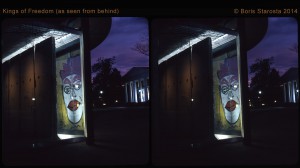 In commemoration of the 25th anniversary of the fall of the Berlin wall, this year we have a supposedly historic piece of Berlin wall grafitti art on our campus, on loan from the Hefner Collection. It is Dennis Kaun’s KINGS OF FREEDOM. I’m still researching the provenance of this artwork, because I’m a little bit suspicious of it, as it is clearly signed “copyright” 1990.
In commemoration of the 25th anniversary of the fall of the Berlin wall, this year we have a supposedly historic piece of Berlin wall grafitti art on our campus, on loan from the Hefner Collection. It is Dennis Kaun’s KINGS OF FREEDOM. I’m still researching the provenance of this artwork, because I’m a little bit suspicious of it, as it is clearly signed “copyright” 1990.
Well, as everybody knows, the Berlin Wall came down in 1989, so this signature right on the artwork means that it was created possibly after the the wall came down, after the panels were dispersed, and to my mind that means the work cannot be historically significant. (It would then just be a larger version of the thousands of “chips” of Wall concrete, later dusted with a bit of spray paint, that were hawked as memorabilia in the aftermath of the fall of East Germany and Soviet Communism).
I’ve tried to research the KINGS online and have found precious little information about them, that is not sourced by the Hefner collection, which is of course proud of the artwork it owns. Nowhere can I find any independent information as to when and under what circumstances the KINGS were painted, and the Hefner collection, for its part, is silent about those circumstances, making only ambiguous statements about how the art was made. For all we know, the panels came to the artist after having been removed from the Berlin Wall, then painted in some studio somewhere, taking advantage of the historic nature of the panels to subsequently profit from them. That would make the piece commercial art, and not proper graffiti (which to me is by definition fine art and/or political speech, typically made under duress – illegally, trespassing, etc.).
For me, Berlin Wall graffiti has meaning if it was painted before there was any hope of the wall ever coming down – and of course, there were hundreds of examples of graffiti art of that kind on the Berlin Wall. The wall was actually several meters inside of the border with East Germany, so all those works were made illegally (however with little risk of sanction). Why couldn’t the Hefners have obtained such a work? If the KINGS OF FREEDOM had any kind of significance, surely there would be more information about them online. Right now to me, it feels like the importance of the piece is manufactured and spurious.
If anyone can shed some light on this question, I’d be very happy about it! Despite my doubts about the provenance of the piece, I do like what it says…
The photograph shows the installation on the grounds of the University here. One half of the front of the panel is seen reflected in the glass of the installation enclosure, while we can simultaneously observe the back of the panels, more dimly illuminated. To me the contrast is telling: the back shows nothing but numbers – the essence of inhumane bureaucracy, while the front shows wild colors and passion – symbolic of the delightful chaos that flourishes under liberty.
This contrast reminds us that it is bureaucracy that is the fertile ground from which tyrants will sprout. We need to fear bureaucracy, not the tyrants themselves. By the time we have tyrants to fear, it is too late.
Shot with my Sputnik (thank you forever, Chuck), f22, 30 secs on Fuji RXP 400 asa. Probably could have used a stop more exposure.
You must be authenticated to view comments.